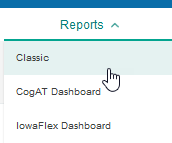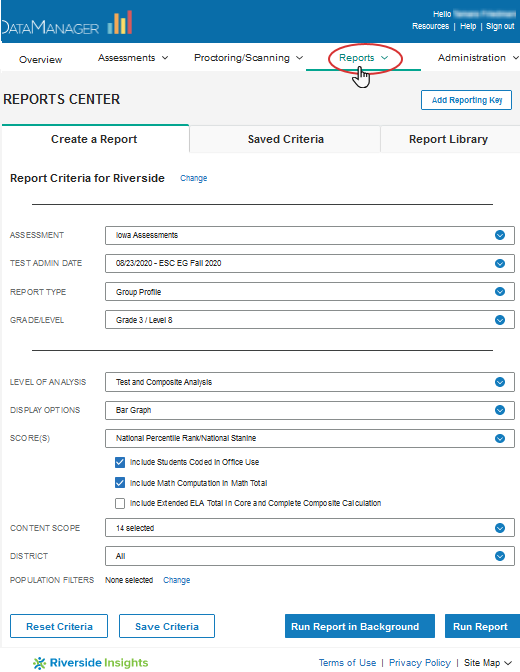 See the changes.
See the changes.
Data Package: Online Testing or DataPlus |
Role: Account Holder, Super Admin, Administrator, Teacher, or Digital Resource & Reporting Access |
You can specify criteria and run reports on the Create a Report page.
Report options and availability vary according to the following:
● Your role and location. You can create and view reports only for your own location level and those below you.
● The tests that have been administered to students, entered in the database, and marked as completed.
● The options you select as you move down the list of criteria. As you select options, subsequent fields with dependencies on those options may change. (Common fields that produce these changes include REPORT TYPE, LEVEL OF ANALYSIS, and DISPLAY OPTIONS.) When this happens, the page reloads to display new or adjusted fields.
Note: If you are transitioning
from Interactive Results Manager (IRM) to DataManager
(DM), some menu labels and report names have changed.
 See the changes.
See the changes.
1. Open the Create a Report tab in the Reports Center by doing one of the following:
– If you are a Teacher, Administrator, or above, click the Reports menu at the top of the page at any point after signing in. Select Classic if provided a drop-down option.

Note: If your institution has purchased IowaFlex or another applicable product, you will also see the option to select the IowaFlex Dashboard or CogAT Dashboard. For instructions on these options, see the related dashboard overview sections.

– For
individuals with Teacher roles and above, you can also open the Create a Report tab from the
Test Events Overview page by clicking See
reports in the  Complete Tasks box.
Complete Tasks box.
– For reports-only access users with a web Reporting Key, create your account or sign in to your existing account and enter the Reporting Key provided by your school or district administrator.
Note: If you have access to multiple locations, enter each new Reporting Key once. Subsequently, you can select the location from a Select Report Criteria for drop-down list at the top of the Create a Report tab.
2. In the ASSESSMENT list, select the test your students took. If there is more than one option, select the one for which you want to run a report.
3. From the TEST ADMIN DATE list, select your test event if different from the default. Test events are indicated by their date and name. They are sorted by date, most recent first.
4. In the REPORT TYPE list, select the report you want to produce. Short descriptions for each report are provided below, along with links (More...) to fuller descriptions with samples. Click the Instructions link (on the line below More...) to view field-level descriptions and instructions for entering selections in the remaining fields of each report.
Note: Reports and fields are listed here in the same order as they appear on your DataManager platform.
– Student Roster – provides scores
by test and composite or skill domain for each student in the selected
group.  More...
More...
 Instructions:
Click to open a table with definitions for the remaining fields. When
you have entered your report parameters, continue
with the next step.
Instructions:
Click to open a table with definitions for the remaining fields. When
you have entered your report parameters, continue
with the next step.
– Multimeasure Student Roster – allows
you to create up to ten columns across multiple test administrations,
test types, grades, and levels for each student in a selected group. This
report also provides a PERFORMANCE BANDS option, which allows you
to specify performance indicator labels and values that color code the
test results for each student.  More...
More...
 Instructions:
Click to open a table with definitions for the remaining fields. When
you have entered your report parameters, continue
with the next step.
Instructions:
Click to open a table with definitions for the remaining fields. When
you have entered your report parameters, continue
with the next step.
– Student Profile – provides one of
several types of data output for each student's scores in a selected group.
 More...
More...
 Instructions:
Click to open a table with definitions for the remaining fields. When
you have entered your report parameters, continue
with the next step.
Instructions:
Click to open a table with definitions for the remaining fields. When
you have entered your report parameters, continue
with the next step.
– Student Label - provides printable
student labels containing student and test information, including scores
based on vocabulary and comprehension tests.  More...
More...
 Instructions:
Click to open a table with definitions for the remaining fields. When
you have entered your report parameters, continue
with the next step.
Instructions:
Click to open a table with definitions for the remaining fields. When
you have entered your report parameters, continue
with the next step.
– Group Roster – provides test and
composite scores or skill domain scores for each selected group—class,
building, district, system, region, or state.  More...
More...
 Instructions:
Click to open a table with definitions for the remaining fields. When
you have entered your report parameters, continue
with the next step.
Instructions:
Click to open a table with definitions for the remaining fields. When
you have entered your report parameters, continue
with the next step.
– Subgroup Roster – provides test
or composite scores for all subgroups or a selected subgroup—gender, federal
race/ethnicity, programs, and/or administrator codes.  More...
More...
 Instructions:
Click to open a table with definitions for the remaining fields. When
you have entered your report parameters, continue
with the next step.
Instructions:
Click to open a table with definitions for the remaining fields. When
you have entered your report parameters, continue
with the next step.
– Group Profile – provides the average
score for a selected group by test, skill domain, content, cognitive
level, proficiency level, and/or any population parameters you specify,
with some reports offering the option to view longitudinal information
where relevant data exists.  More...
More...
 Instructions:
Click to open a table with definitions for the remaining fields. When
you have entered your report parameters, continue
with the next step.
Instructions:
Click to open a table with definitions for the remaining fields. When
you have entered your report parameters, continue
with the next step.
– Word Decoding Skills Roster –
applies to Levels 1 and 2 of the GMRT
Word Decoding subtest (grades 1 - 2). Shows the number and category of
errors made by class on the Word Decoding subtest of GMRT
Level 1 (Form S) and Level 2 (Form S and Form T). More...
More...
 Instructions:
Click to open a table with definitions for the remaining fields. When
you have entered your report parameters, continue
with the next step.
Instructions:
Click to open a table with definitions for the remaining fields. When
you have entered your report parameters, continue
with the next step.
– Class Word Decoding Skills –
provides the overall number of errors made by a class on each of the skills
in GMRT Level 1 (Form S) or Level
2 (Form S and Form T).  More...
More...
 Instructions:
Click to open a table with definitions for the remaining fields. When
you have entered your report parameters, continue
with the next step.
Instructions:
Click to open a table with definitions for the remaining fields. When
you have entered your report parameters, continue
with the next step.
– Student Word Decoding Skills –
shows the skill category and number of errors made by each student in
a class on the Word Decoding subtest of GMRT
Level 1 (Form S) and Level 2 (Form S and Form T). Skill Categories can
be expanded to see the exact errors students made on the subtest.  More...
More...
 Instructions:
Click to open a table with definitions for the remaining fields. When
you have entered your report parameters, continue
with the next step.
Instructions:
Click to open a table with definitions for the remaining fields. When
you have entered your report parameters, continue
with the next step.
5. (Optional)
 Save
the current selection criteria for future use.
Save
the current selection criteria for future use.
6. Run the report using one of the following options.
To do the following... |
Follow these instructions... |
Run the report immediately as you wait. |
a. Click Run Report. A progress bar appears. When the report has finished running, it appears on a report page. b. See View Reports for information about the report page. Note: The Run Report option is not available for Data Export or Scoring Service Print Style reports. These report types must be submitted to run in the background. |
Submit the report to run in the background. |
a. Click Run in Background. A Specify a Report Name dialog box opens. The report name defaults to the Report Type.
b. (Optional) Change or add to the Report Name. Note: Do not use the following characters in the Report Name: semicolon (;), colon (:), asterisk (*), question mark (?), slash (/), backslash (\), pipe (|), angle brackets (< >), or quotation marks (“). c. Click OK. A confirmation box informs you that the job has been submitted successfully. d. Click OK. The report is submitted. When it is finished running, you can open it in the Report Center . e. See Using the Report Center for information about retrieving reports. Note: Completed jobs are available in Report Center for five days after they have finished running. |
See Also: